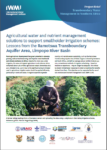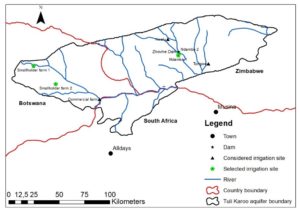On the 19th of August 2020, country representatives, project partners, and the IWMI project team met online to discuss progress on the different project components of the ongoing study of conjunctive water management in the Tuli Karoo Transboundary Aquifer. The current global pandemic meant a workshop planned for May 2020 in Zimbabwe had to be postponed and reconceptualized for later in the year, prompting the need for this update meeting. A core team of 15 was in attendance, which included the Limpopo Water Watercourse Commission (LIMCOM) and the Southern African Development Community Groundwater Management Institute (SADC-GMI). A recent project partner, Climate Resilient Infrastructure Development Facility (CRIDF) has come on board to collaborate on the integrated groundwater monitoring work, joining forces to cover Zimbabwe while IWMI supports work in Botswana and SA. Presentations on ongoing activities related to specific project components (i) Groundwater Monitoring Network design (ii) Agriculture Water Management and (iii) Managed Aquifer Recharge, preceded the discussion.
Project leader, Jonathan Lautze (IWMI) briefly reviewed the premise and aims of the Tuli Karoo project, as well as progress the first year which was focused on stakeholder engagement, website creation and the Transboundary Diagnostic Analysis (TDA). He then highlighted how the five key issues in the TDA formed the basis for activities in the project’s second year, focused prominently on transboundary groundwater monitoring, managed aquifer recharge suitability assessment and agriculture water solutions. He then reviewed progress in each of these components and adaptations made in light of Covid19 restrictions. Responding to a question on whether there are any adjustments to project activities based on Covid19 disruptions, Jonathan indicated that there has been greater reliance on partners for field activities. Further, some of the key issues coming out of the TDA will be put on the agenda and can be taken forward through concept development and collaborations.
Girma Ebrahim (IWMI) presented on the groundwater monitoring network designed for the Tuli Karoo TBA in close consultation with officials from Botswana, South Africa and Zimbabwe and SADC GMI. He noted that although monitoring groundwater is fundamental in understanding the groundwater system’s processes and interactions, and provides insights into managing abstractions and the effects of climate change, monitoring efforts are currently weak and fragmented in the Tuli Karoo TBA. The uneven and porous spatial distribution of the monitoring network in Botswana and South Africa, as well as the absence of observation boreholes in Zimbabwe are some of the challenges impacting effective monitoring of the Tuli Karoo TBA. It was raised to consider other existing or abandoned boreholes currently not in use for use as monitoring boreholes in Zimbabwe, however consideration has to be taken into account of the disadvantages associated with the use of such boreholes for monitoring such as their design as production boreholes, absence of drilling information and ownership issues.
A baseline groundwater monitoring network for the Tuli Karoo aquifer was therefore designed using combined hydro-geological and geo-statistical approaches. It was found that about 58 [1]monitoring boreholes are needed to optimally monitor the groundwater level in the transboundary aquifer. The cost limitations of installing all monitoring boreholes were noted, raising the possibility of prioritizing particular boreholes in a phased approach. As a first step, four observation wells (one in each country and one strategic well) were to be installed with a real-time monitoring system to provide fast and reliable data that can be acted on and reported in a timely manner.
The real-time monitoring system was developed by UIT (Unmelt-und Ingenieurtechnik) GmbH Dresden based in Germany and can monitor water level, temperature and electrical conductivity. In the context of COVID19 this plan was revised to install three in Botswana and one in South Africa as a hydrocensus to inform borehole location could not be conducted in Zimbabwe at the onset of travel restrictions. One data logger has successfully been installed in Botswana just before the travel restrictions. Online training on hardware and software components will be provided by UIT to focal persons from each country as well as provide remote support for field installation.
Work on assessing suitability of MAR in the Tuli Karoo TBA using GIS based multi-criteria decision analysis was presented by Pako Mowaneng, a student at the University of Botswana. The use of GIS base MCDA has proven to be an invaluable tool in the selection of MAR sites. It represents a useful way to assist in planning for groundwater management using publicly available data. The presented data and analysis provided early stage findings on mapping MAR areas with focus on using the spreading method in semi-arid areas. The study provided evidence that some of the criteria heavily influenced the outcome of site suitability. Criteria such as soil showed high sensitivity thus may have skewed results to favor the soil criteria. With at least 80% of the area in the Tuli Karoo TBA in suitable or better class for MAR, it shows the area has great potential for recharge sites. The suitability map produced is based on physical environment criteria of the area thus may not provide the most ideal sites for MAR. Criteria such as the distance to water sources, water quality, depth to groundwater, demand and intended use of the stored water have not been considered. There is still need for the data to be validated against field data, which currently proves challenging due to travel restrictions imposed by the Covid-19 pandemic.
Manuel Magombeyi who leads the Agriculture water management component, presented on how work on improving soil-water and nutrient management to reduce excessive irrigation and washing of nutrients from the crop root zone was progressing in selected smallholder irrigation plots in Botswana and Zimbabwe. Similar smallholder irrigation plots could not be identified in South Africa. Two simple soil-moisture and nutrient management tools, the Chameleon (soil-moisture) sensor and the Full-Stop (wetting front detector), are currently being piloted in four plots to monitor soil-moisture and nitrate levels in the soil. Irrigation water savings of 10% have already been observed for sugar bean, green pepper and tomatoes planted in the plots. With the reduced crop stress, irrigation water productivity for flood irrigation increased by 11% (from 0.3 to 0.4 kg/m3), while for drip irrigation it increased by 7% (from 14 to 15 kg/m3). The flood and drip irrigation systems realized benefits of water and nutrient management to different levels, with drip irrigation (162 m3/ha) still a better technology to save water for crop production if the infrastructure is available, compared to flood irrigation (7 900 m3/ha). Field support to farmers was lacking due to travel restrictions and may have impacted on the results obtained. Continued support to farmers and extension officers in the use of the management tools is being provided albeit remotely through Whatsapp and text messages in the current restrictive environment. Soil-water and nutrient management tools will have long-term effects on crop yields, food supplies, income, livelihoods, and enhance the resilience of smallholder farmers in similar agroecological settings.
Further engagement was provisionally agreed for later this year in November as it would be an opportune time to review activities again with a broader audience and possibly coincide with the Limpopo Groundwater Committee (LGC) meeting. Jonathan Lautze then concluded by thanking those in attendance and the team for the good progress made under the circumstances.
Meeting presentations can be accessed through this link.
[1] (4 existing monitoring boreholes, 8 production boreholes and 44 new proposed observation boreholes)









I was not in the list of those who recieved the minutes and presentation . Maybe this is because i did not attend the meeting but i understand Ms Montlhabanedi did apologize on my behalf
This is a welcome development. Thanks IWMI.